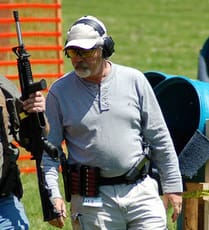Think it can’t happen to you? Guess what – it can. Get the neurons and synapses confused with things other than the task immediately at hand and it won’t matter how many certifications or how many years of experience you’ve had. Just ask firearms instructor Michael Craig. By all accounts he’s not the first guy you’d expect to unintentionally loose lead in an unintended direction. Especially when that direction includes his own right leg . . .
But he did. Few of us can match Craig’s CV:
According to the Ohio Shooting Sports website, he has been involved with firearm instruction and training for the past 20 years and is a National Rifle Association Certified Home Safety Instructor, a NRA Certified Pistol Instructor, an NRA Personal Protection in the Home Instructor and a Certified NRA Range Safety Officer, among other qualifications.
But no matter how many NRA classes you’ve ponied up for or how long you’ve been shooting, our research shows that keeping your finger off the trigger ’til you want to shoot prevents 99 and 44/100% of all negligent discharges.
Craig was teaching a class and demonstrating “how to take a defensive stand and shoot close to a target.”
Craig told Deputy Darrin Bohn he had taken the Glock Model 35 out of his holster, fired two shots, holstered it, pulled it out of the holster and fired two more shots.
When Craig went to reholster the gun for the third time, he pulled the trigger and shot himself in the right calf, Craig told Bohn.
And the anti-Glockinistas jump on the dog pile in three…two…one…. To save a few million electrons in the comment section, note that Craig admitted that he pulled the trigger on the shot that Grebnered his leg so, Glock or not, whatever gun he was packing would have “gone off” like his 35 did. Just sayin’.
No matter the gun, it pretty much all comes down to focus with a dash of muscle memory thrown in for good measure. Craig was probably sure nothing like that would ever happen to him. How many of us have thought the same thing? So he’s a rare Cautionary Tale of the Day winner, but we’re guessing Michael would be just fine with that if it gets the point across to even one other gun owner.





Should have had a New York trigger. Heavy trigger pulls completely stop negligent discharges from happening. I read it on the Internet so it must be true.
Doesn’t sound irresponsible to me. He made a mistake and admitted it… none of that “the gun went off” crap.
I noticed that too.
“…he pulled the trigger and shot himself in the right calf, Craig told Bohn.”
Kudos to him for being able to swallow his pride and say that. He made a mistake, admitted it, and will probably correct it.
That’s as maybe….but it’s still negligence on his part.
+1
Agreed. By removing the IGOTD TTAG is calling this an acceptable negligent discharge.
There are varying degrees of IGOTD, IMHO. There’s the malicious stupidity variety, then there is this type, which is an honest mistake.
“Craig was probably sure nothing like that would ever happen to him.” – I’m not willing to assume that. I’ve never met the man.
How many of us have thought the same thing? – I can only speak for myself, and I can assure you that I’ve never had those thoughts.
He made a mistake, he paid the price. No one else was hurt. IGOTD just seems a little harsh.
Agreed. Are their not more egregious examples of Idiot gun owners to bestow this award upon on this fine day?
+1
How about “Cautionary Tale of the Day?”
That works. In this case. Post amended.
Nice! Accidents happen and nobody is immune.
Lesson Learned: The price of not shooting yourself is eternal trigger control.
So just because a guy has lots of experience training and admitted he makes a mistake, that makes what he did ‘responsible’ firearms handling?
Dan Zimmerman, what do you call it when someone breaks rules 2 and 3 and puts a round into their own leg, if not irresponsible?
If people have negligent discharges more with Glocks then with other guns then people need to be aware of that. People jump on Serpa holsters because people have negligent discharges due to a faulty design but I’d say if the gun you are using has a negligent discharge rate higher then any other gun, then maybe the gun does have something to do with it. Glock obviously makes a good reliable gun and I”ll probably pick one up eventually but would anyone walk around with a 1lb trigger in single action mode? You could still just keep your finger off the trigger until you’re willing to fire.
The trigger can have a .01 lb weight-and unless its engaged by an object or a human finger, it will not fire. Blaming the gun in cases like this is like blaming a car accident on the fact that the shift lever doesn’t have a 10lb detent.
My point is if you have a .1lb trigger, you will have more negligent discharges. People aren’t always perfect. This guy has trained with Glocks for how long and he still screwed up. You think he didn’t know the 4 rules?
with a weight like that, it’ll certainly go off if you drop it, or just move the gun around too quickly. thats why SAAMI has specific tests to ensure guns are drop safe.
One could presume that the glock is simply a popular first time gun, thus it’s high rate of NDs could be associated to inexperienced gun owners. I’m just speculating though.
Exactly – Correlation is not causation.
The main problem with Glocks is that people bill them as nearly dummy proof in the stores. The problem is that they aren’t any safer than any other pistol if you don’t observe the four rules.
That said, a former coworker of mine laid his motorcycle down on his Glock one day when it was raining. The gun prevented road rash on his hip and he didn’t get a piercing in his butt cheek, either. So, just as you can never out shoot the factory accuracy of a good gun, you’ll never be safer than a well made one either.
I would not put him anywhere in the same league as most IGOTD winners. But it’s RF’s website and he makes the rules.
hhmm well I hope he displays it proudly and tells everyone you don’t want to get one of these. Yeah it was a mistake and it goes to show you that this can happen to anyone, even someone with his back ground. Hope he is back on his feet soon!
Sounds like he has a bad case of Glock leg. Seriously, it could happen with any gun. Hope he gets back to 100% soon.
I guess the Mathematics Nazi Party doesn’t have as large of a following as the Grammar Nazi Party. Not to nitpick, but 44/100% should be simplified to 11/25%….
🙂 Completely being a smartass here. I actually could give two flying shits about it. Hope Michael recovers quickly and completely.
Reference to Ivory soap and the movie by almost the same name.
Ninety-nine and forty-four one hundredths percent is 99.44%. No LCD need apply.
Yep. Screw odd-ball fractions. Give me percentage any day. We all know, however, the Ivory Soap floats because it’s so full of air. Pure air. When a man sets out to be a trainer of shooters he has an obligation not to hot dog, mustard guns aside. There is much to be said for a thumb safety or de-cocker if one is going to demonstrate speed repeatedly. He’s actually lucky he didn’t demonstrate the Glock’s de-cocker which is as simple to apply as its triple safety.
Give me a percentage any day. We all know that Ivory Soap floats because it’s full of air. I carry a Glock but considering reholstering it a careful slow maneuver, given the 3 automatic safeties. He’s lucky he didn’t demonstrate a Glock’s automatic de-cocker…..
Glocks have their adherents, and I’ll not pile on. But I’m partial to the external safety on the 1911s that goes on each and every time I’m done shooting. As natural and second-nature as I can train it to be.
That said, any gun will usually work as designed.
Yes, if the weapon had a safety (rather than a trigger on a trigger) and he had a habit of putting his weapon on safe before reholstering, this would be less likely to happen.
How much less likely? Probably not as much as you’d intuitively think. An external safety can also be forgotten during certain drills. Trust me – I know.
Also, a safety increases complexity of a firearm’s manual of arms. This can create more uncertainty and hesitation, especially in novices (they can repeatedly leave the safety off). I’m 99% positive that 1911 style handguns are more safe for me, but I have no idea if they would make everyone more safe.
If that’s you’re routine sure. A person transitioning to a Glock from a an M1911 could have that issue. I like the Glock because I’m not really used to using a safety – I spent years carry a C-7 (an M-16A2 covered in maple syrup that has full auto) and I rarely used the safety. On base, the weapon would be kept unloaded, and on patrol it would be kept loaded and chambered with finger outside the trigger guard. Safety would only be used when sleeping or eating in the field, or for certain evolution on the range. So to me, don’t put your finger on the trigger until you’re ready and willing to shoot.
Is there any circumstance where you might need to re-holster so quickly that you run the risk of an ND? I am still so paranoid about re-holstering at IDPA that I remove my holster, put the gun in and then put the rig back on.
I understand. However, perhaps you’re developing less than ideal muscle memory that could harm you during an actual DGU situation?
Re-holstering during a competition event would seem like an ideal place to learn from and identify minor mistakes.
This is why I specifically like the design of the XD series. When I holster my XDm, I move my thumb to the top of rear of the slide. It’s still a solid grip on the gun, but I’ve taken my hand off the backstrap that way, which engages the grip safety. Now both the grip safety and the trigger safety are engaged. It’s a little added assurance to prevent an ND. If the trigger were to snag on something on the way in, the grip safety, if working properly, should prevent the gun from firing.
But tbe incident shows that while the operator is the ultimate safety mechanism he is also weakest link. You need more than a drop safety on a gun. Glocks are unsafe.
Humans are unsafe. The handgun wouldn’t have discharged if he hadn’t pulled the trigger.
This.
As mentioned earlier; it could still happen with a gun like a 1911; if he was in such a hurry to re holster it would be very easy to forget to flip the safety back up.
If he kept a full grip this could have just as easily happened with an XD or an M&P as well.
That’s not the point though. It’s not binary. Would it be more or less likely with a 1911? What about someone who’s trained with a glock and somebody’s who has trained with a 1911? With a 1911, you can train yourself to activate the safety, and prevent yourself from accidentally pulling the trigger. With a glock, you don’t even have that option.
He didn’t WANT to pull the trigger. Him pulling the trigger was obviously something unconscious. I mean, why do we tell people to keep their finger off the trigger? Why don’t we just tell them to NOT pull the trigger?
“Grebnered”? What does it mean “to Grebner”? Origin?
Ohhhhhh, Tex Grebner. Got it.
Perfect example of a real man. Willing to own up to his own. Not blaming the Glock like so many others who are just flat out liars. Glocks are NOT for those who can’t resist pulling the trigger at the wrong time.
At least with NDs like this, you can almost be sure it wont happen a second time, you can bet he’ll never forget this hard learned lesson.
When we handle firearms or are around other people handling firearms, we need to reinforce an incredibly strong safety ethic. Anytime a person violates one of the four firearm safety rules, everyone who sees the screw up should call them on it … and the offender should graciously thank them for pointing it out.
When shooting with my dad a couple weeks ago, I saw him put his finger on the trigger when he wasn’t aiming at the target. I immediately told him about it in a friendly and yet assertive tone of voice. I was very disappointed when he responded with an attitude. But too bad. He had his finger on the trigger when he shouldn’t have. I really don’t care if he was embarrassed — he should have been.
He later apologized for his mistake and his attitude … recognizing that I was looking out for the safety of everyone around. And that is the road to a stronger safety ethic.
I carry a Springfield Armory XD every day in a holster. I teach concealed carry as well. The other day I was re-holstering and being in a rush somehow my finger got trapped between the trigger and the holster as I started to slam it back in. That somehow was completely my fault!!! Had I pushed a bit harder I would have sustained a gunshot to the leg. We have a saying at our range “We don’t trust anyone, including ourselves”. That nanosecond of inattention to detail causes these NDs to happen.
The way I was instructed was to never have your finger on the trigger unless your sights were on target. It would not matter what make of gun it is, once your sights are off the target, the finger comes off the trigger. I do prefer the 1911 with both the thumb safety and the grip safety. The muscle memory tought to me was the safety goes on and the finger comes off the trigger and pointed along side the slide as soon as the sights are off the target.
It was a rifle, not a pistol, but it’s worth mentioning. I know a retired Marine who was tasked with cleaning some rifles after his unit had fired on the range. Each gun was checked by the Range Officer before it left the range. Each gun was checked by the armorer as it entered the Armory. My friend failed to check it. He shot another man in the leg. Surely, you’d say, after the gun had been checked by two competent officials, you could assume it was empty. But it wasn’t.
Lesson: don’t make assumptions about guns. Make sure the gun is empty.
It helps if your not a person who’s “over-confident” (and I’m being generous). I met him once, and he pretty much acted like he owned the private range I’m a member of. I just shook my head when I read this- it had to happen….
Devoted to the Glock for certain uses and calibers, I still holster it slowly and carefully. It has three safeties but they’re all automatic. Craig was lucky he didn’t demonstrate Glock’s famous auto-decocker as well.
Concerning this “incident” this article says it all.
http://www.activeresponsetraining.net/trigger-finger-positioning-hand-clenches-and-accidental-discharges
Comments are closed.